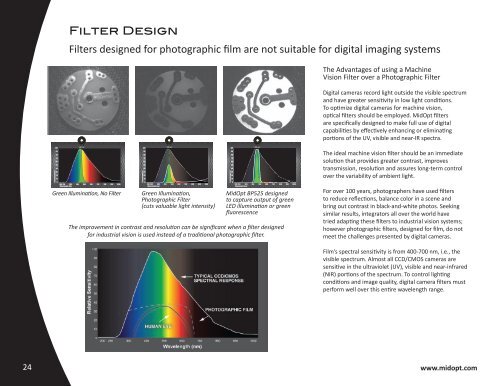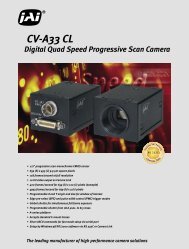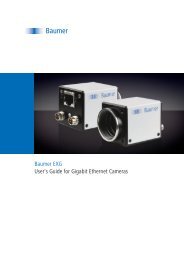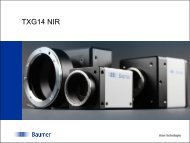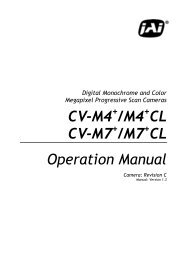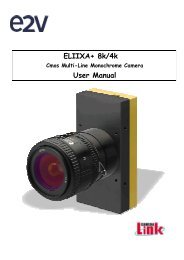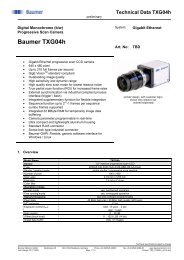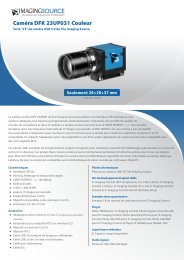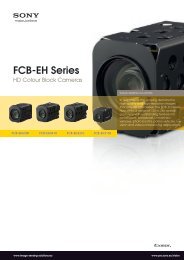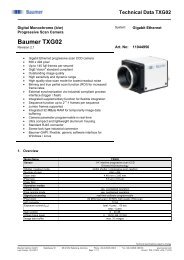MidOpt Filters Where Image Quality Begins - Site ftp Elvitec
MidOpt Filters Where Image Quality Begins - Site ftp Elvitec
MidOpt Filters Where Image Quality Begins - Site ftp Elvitec
You also want an ePaper? Increase the reach of your titles
YUMPU automatically turns print PDFs into web optimized ePapers that Google loves.
Filter Design<br />
<strong>Filters</strong> designed for photographic film are not suitable for digital imaging systems<br />
The Advantages of using a Machine<br />
Vision Filter over a Photographic Filter<br />
Digital cameras record light outside the visible spectrum<br />
and have greater sensitivity in low light conditions.<br />
To optimize digital cameras for machine vision,<br />
optical filters should be employed. <strong>MidOpt</strong> filters<br />
are specifically designed to make full use of digital<br />
capabilities by effectively enhancing or eliminating<br />
portions of the UV, visible and near-IR spectra.<br />
LED<br />
Green Illumination, No Filter<br />
Transmission (%)<br />
100<br />
90<br />
80<br />
70<br />
60<br />
50<br />
40<br />
30<br />
20<br />
10<br />
0<br />
LED<br />
530 nm<br />
200 250 350 450 550 650 750 850 950 1050<br />
Wavelength (nm)<br />
Green Illumination,<br />
Photographic Filter<br />
(cuts valuable light intensity)<br />
The improvement in contrast and resolution can be significant when a filter designed<br />
for industrial vision is used instead of a traditional photographic filter.<br />
Transmission (%)<br />
100<br />
90<br />
80<br />
70<br />
60<br />
50<br />
40<br />
30<br />
20<br />
10<br />
0<br />
LED<br />
530 nm<br />
200 250 350 450 550 650 750 850 950 1050<br />
Wavelength (nm)<br />
<strong>MidOpt</strong> BP525 designed<br />
to capture output of green<br />
LED illumination or green<br />
fluorescence<br />
The ideal machine vision filter should be an immediate<br />
solution that provides greater contrast, improves<br />
transmission, resolution and assures long-term control<br />
over the variability of ambient light.<br />
For over 100 years, photographers have used filters<br />
to reduce reflections, balance color in a scene and<br />
bring out contrast in black-and-white photos. Seeking<br />
similar results, integrators all over the world have<br />
tried adapting these filters to industrial vision systems;<br />
however photographic filters, designed for film, do not<br />
meet the challenges presented by digital cameras.<br />
Film’s spectral sensitivity is from 400-700 nm, i.e., the<br />
visible spectrum. Almost all CCD/CMOS cameras are<br />
sensitive in the ultraviolet (UV), visible and near-infrared<br />
(NIR) portions of the spectrum. To control lighting<br />
conditions and image quality, digital camera filters must<br />
perform well over this entire wavelength range.<br />
24<br />
www.midopt.com


